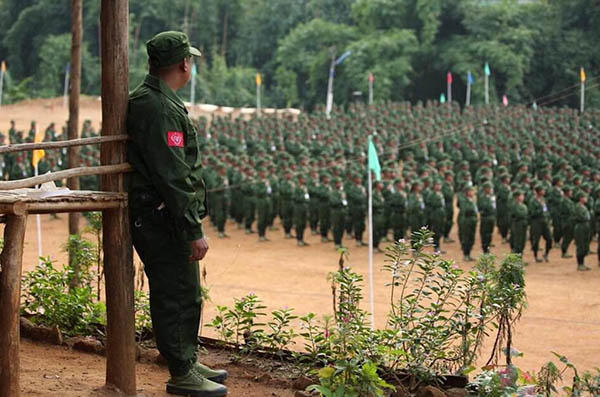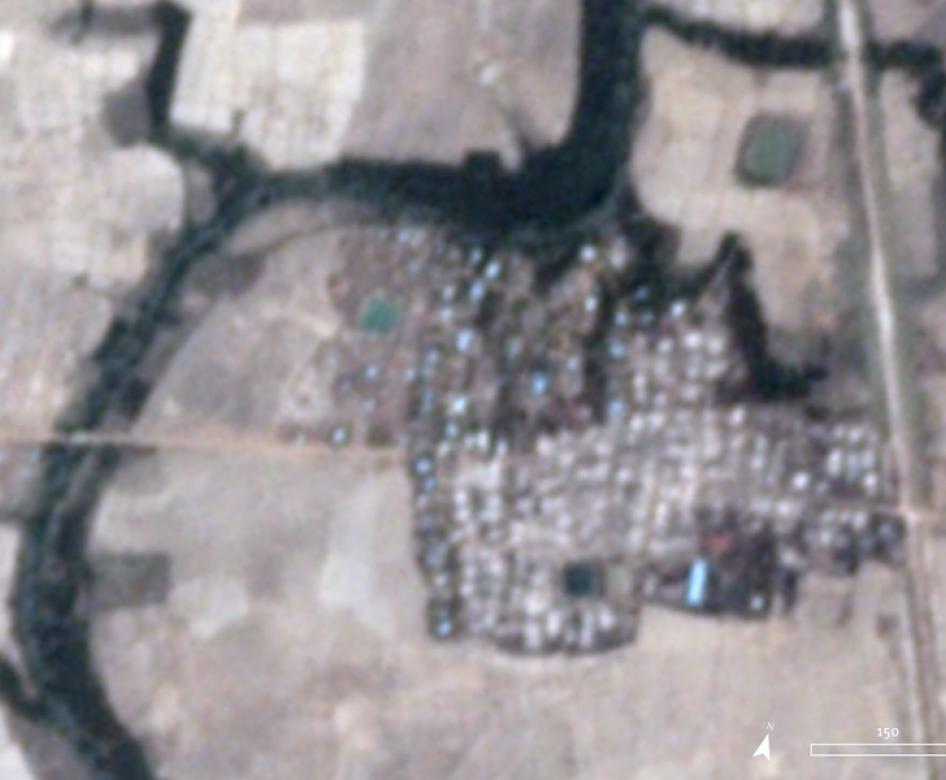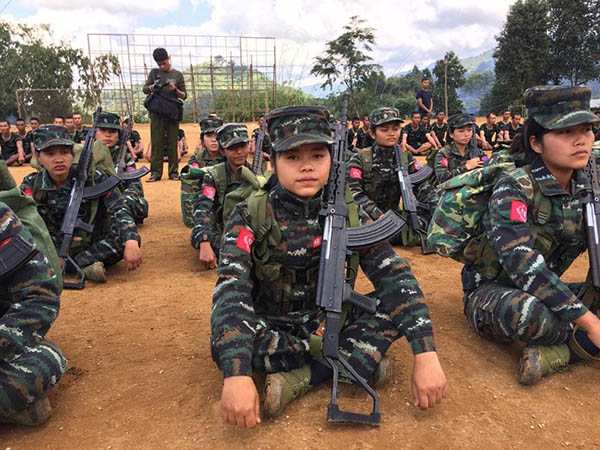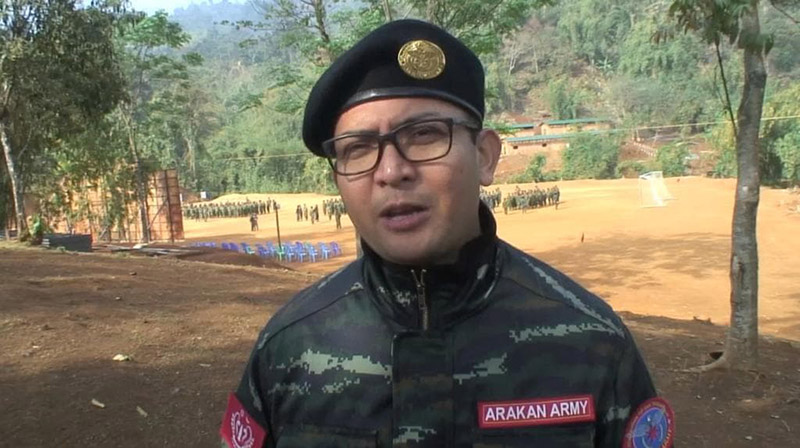While the world’s attention is focused on COVID-19, war is brewing in the jungles of western Myanmar. The Arakan Army, or AA, was formed just a few years ago by students, workers and farmers but has learned the ruthless tactics of guerrilla warfare quickly.
Maj. Gen. Twan Mrat Naing, its commander, aspires to no less than forging a new nation.
“My personal dream,” he said, “is to see our national flag at the Olympic Games and to hear our national anthem sung.”
From just 26 armed men in 2009, the AA now has more than 20,000 soldiers. Twan Mrat Naing aims to swell their ranks to 70,000, which he hopes will be enough to tip the balance and kick the Tatmadaw, as the Burmese army is known, out of Rakhine state.
Twan Mrat Naing told Coconuts in a recent interview what it is that makes him lead the AA into battle.
“I was meant to be a freedom fighter since I was in high school,” says Twan Mrat Naing, who at 41, has been instrumental in building the army into the fighting force it is today.

‘That’s Terrorism’
In January 2019, the Burmese military officially designated the AA as a terrorist organisation, and the government followed suit this past March after ceasefire talks broke down. President U Win Myint declared the group a “a danger to law and order,” citing attacks against the military, police and security outposts that include allegations of torture and assassination.
Evidence on the ground in Rakhine tells a different story. There, as in other areas of Myanmar, complaints portray the Tatmadaw like an occupying army. In May, witnesses said they saw soldiers enter the Let Kar community before gunfire and flames broke out. Human Rights Watch estimated at least 200 homes were put to the torch much in the same way Rakhine’s ethnic Rohingya villages were destroyed.
The major-general said that many ethnic groups, including his own, the Rakhine, are racially targeted by the Burmese military and says the AA tries to protect the civilian population.
Myanmar army uses helicopters, fighter jets against civilians in Rakhine
“These are our people, our blood, so we want to protect them and we are sad to see people get killed by indiscriminate artillery bombardments and arson attacks by the Burmese military,” he said in the clear, American-accented English he learned as a tour guide.
“Our troops never stay in the villages. We have our positions in the jungle, but whenever the Burmese lose a fight they go into the villages and attack the people. That’s terrorism,” he added.
Civilians have been dying in the fighting, however. In April, a United Nations worker was killed while transporting COVID-19 test samples. Both side blamed each other for his death. Last month, the Tatmadaw said it would discipline soldiers filmed beating captives aboard a boat.

Whereas other regions comprising Myanmar’s ethnic mélange have been fighting for independence for decades, Rakhine’s independence movement is relatively young.
It’s where the Rohingya Muslims lived until they were brutally driven from their homes and into Bangladesh three years ago by the Burmese army. Unlike the Rohingya, the Arakan Army is predominately drawn from the majority Rakhine Buddhist population.
The AA has started to make gains. The AA has attacked Burmese naval patrol boats, military convoys, and an army base in the former Burmese capital Mandalay, where there were many casualties.
But in recent weeks there have been vicious reprisals and the Tatmadaw has targeted civilians, predominately the Rakhine, with attacks some observers say amount to genocide. In scenes reminiscent of the brutality unleashed against the Rohingya in 2017, men have been decapitated and women raped as their villages burned.
Hla Yin Oo, a refugee from Kyauk Taw Township in Rakhine State, told Coconuts the Burmese military had ransacked her village.
Report accuses Myanmar military of ongoing war crimes in Rakhine State
“The Myanmar army bombed my village with jet fighters four or five times a day, then when the soldiers turned up they stole our possessions and abducted some of the villagers. I had my solar panels, my phone, food supplies, and chickens all stolen. The soldiers told us they were going to torch the entire village, so we fled that night,” she said.
Now living in a temporary shelter with other refugees in an area under AA control, Hla Yin Oo said she will only return home when the Burmese army has gone.
The Rakhine share their state with the Rohingya Muslims, many of whom still remain after the Burmese military drove most from their homes in 2017. Although relations between the two have been fraught, there are signs the Rakhine have begun to see their enemy’s enemies as friends.
“The best solution is to stay in harmony, to help each other. We will support the Rohingya and help to punish the perpetrators who committed mass atrocities against the Muslims in Rakhine state,” Twan Mrat Naing said.

History of occupation
In the 18th century, Rakhine state was a wealthy, independent country. With a coastline on the Bay of Bengal, it was able to trade freely with India as well as Europe.
In 1784, it was invaded by the Burmese and a 40-year long war was fought until the British took over coastal Myanmar, then known as Burma, in 1824. When the British left in 1948, the Burmese took over again as occupiers. After almost 250 years of occupation, Rakhine is now impoverished and many Rakhine are forced to emigrate in search of work, with some 40,000 living in Thailand alone.
For those who choose to stay behind, there are few job opportunities. Aye Thazan Khaing is among a growing number of women soldiers in the AA. She explained why she decided to become a soldier.
“I studied at Sittwe University but I was unable to finish my degree. There are no opportunities in Rakhine State, so if I hadn’t joined the Arakan Army, I would struggle in a foreign country to send money home to my family,” she said.
Western engagement
The world woke up to Myanmar’s many simmering conflicts when 700,000 Rohingya Muslims were driven from their homes by the Burmese military in 2017.
Myanmar’s military government is currently on trial in the International Court of Justice in The Hague on charges of genocide in a case brought by the Gambia, a small Muslim nation in West Africa. In preliminary findings, the court ordered Myanmar to take immediate measures to prevent the genocide of the stateless Rohingya, in what might be the beginning of justice for almost two million people.
Since 2010, the West has adopted a policy of engaging with Myanmar, something that’s been criticized as making matters worse for the nation’s many ethnic groups.
Myanmar is an ethnic patchwork and the ruling Burmese make up only around 40% of the country’s population of 54 million. But unless the other ethnic groups, some 60% of the population, which occupy 70% of the land area of Myanmar, are included in any future agreement between the world powers and the Burmese, then conflict will continue to rage in Myanmar as it has done for over 70 years.
Scott Johnson, an activist and political commentator who has been deeply involved with Myanmar for two decades, said the policy of engagement adopted by the West is destined to fail.
Johnson blames the Obama administration for dropping sanctions and installing Nobel Peace Prize winner, Aung San Suu Kyi, who has turned out to be either unwilling or unable to pursue policies that are independent of the ruling generals.
Aung San Suu Kyi, educated in the west and with her cut-glass British accent, is herself from the ruling Bamar ethnic group.
“Since these policies of dropping sanctions and engaging with the military mafia were enacted we have one million displaced people, tens of thousands killed, and wars all over the place. The situation is horrific,” he said.
He explains that the so-called ceasefire agreed in 2015 is a ceasefire in name only. With 20 armed ethnic groups fighting the Burmese military, there is no peace deal and no ceasefire.
“They had a so-called nationwide ceasefire, which wasn’t nationwide and wasn’t a ceasefire. Eight original groups signed and a couple of them were just splinter groups, no bigger than NGOs. There was a lot of propaganda surrounding the ceasefire,” Johnson said.
Military or mafia?
The West held up Aung San Suu Kyi as a beacon for democratic aspirations and has been sparing in its criticism after she proved unable to stand up to the Burmese military machine. This became particularly apparent after her lengthy silence during the 2017 Rohingya massacre.
Maj. Gen. Twan Mrat Naing, the AA commander, said the woman lauded as ‘The Lady’ has been a disappointment and become an irrelevant and embarrassing “white elephant.”
Even if Aung San Suu Kyi wanted to try and force through change, she would find it almost impossible. The constitution, introduced in 2008, was drafted by the military who added a clause granting de facto veto powers by granting it 25% of legislative seats.
Although it only fully controls around 50% of the land area of Myanmar, the Burmese military apparatus is powerful. Meanwhile, evidence piles up of its longstanding and lucrative control of the drug trade and valuable real estate.
“The military is certainly involved in the drugs trade and has been historically, through proxies and militias; they deliberately send drugs into the ethnic areas,” Johnson said, repeating the same point time and again throughout the interview:
“The key element causing all the problems are the Burmese military.”
Hope in unity
Some of the 20 armed ethnic groups in Myanmar are, like the AA, disciplined and organized guerrilla armies. Despite long divisions, alliances between them are starting to form.
The AA has formed the so-called Northern Alliance with the Ta’ang National Liberation Army, the Myanmar National Democratic Alliance Army, and the Kachin Independence Army in the northeastern state of Kachin.
There are vast areas of Rakhine, Shan, and Kachin States where the Burmese military has no control.
In places they behave as provisional governments, such as in parts of the southern Karen State, where the Karen National Union, the political arm of the Karen National Liberation Army, collects taxes in return for providing services such as education, health care and justice.
Johnson believes the AA is one of the most powerful and organized armies the Tatmadaw has faced and could change the situation on the ground sufficiently to make the West, as well as China, India, and Russia, change their Myanmar policy to be less accommodating to the Burmese military.
Related
Report accuses Myanmar military of ongoing war crimes in Rakhine State
Rights group calls for ceasefire between Myanmar military and Arakan Army to ‘protect civilians’
Myanmar army uses helicopters, fighter jets against civilians in Rakhine
Q&A with Arakan Army commander




